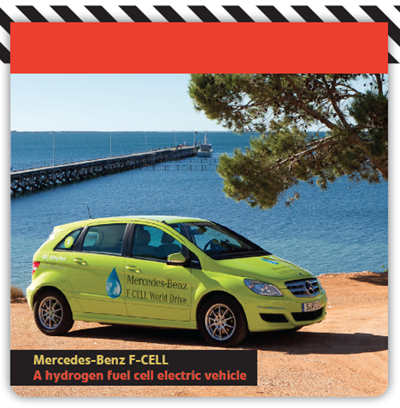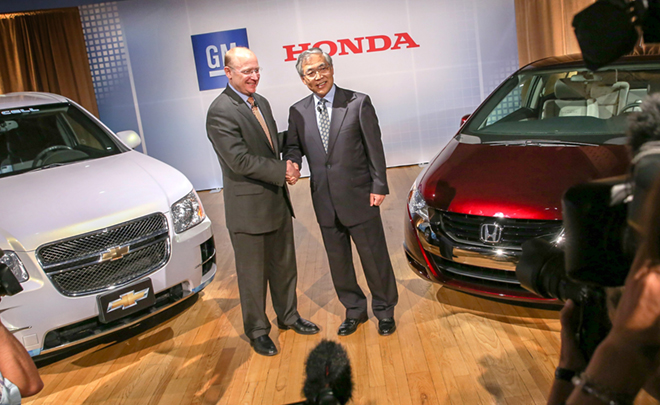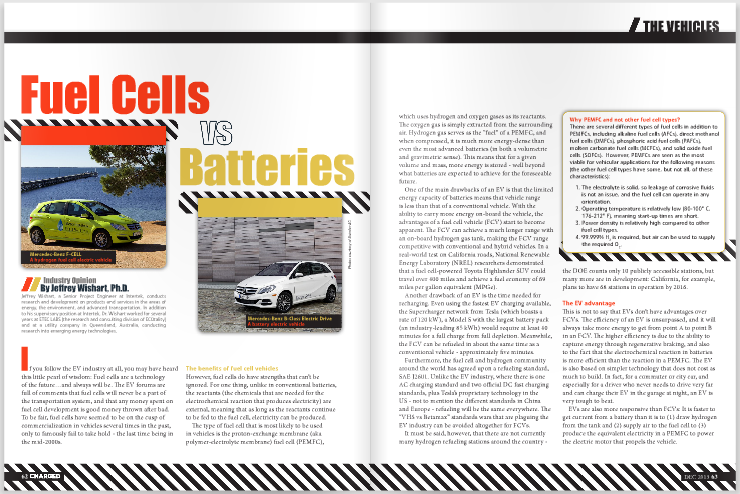Jeffrey Wishart, a Senior Project Engineer at Intertek, conducts research and development on products and services in the areas of energy, the environment, and advanced transportation. In addition to his supervisory position at Intertek, Dr. Wishart worked for several years at ETEC LABS (the research and consulting division of ECOtality) and at a utility company in Queensland, Australia, conducting research into emerging energy technologies.
If you follow the EV industry at all, you may have heard this little pearl of wisdom: Fuel cells are a technology of the future…and always will be. The EV forums are full of comments that fuel cells will never be a part of the transportation system, and that any money spent on fuel cell development is good money thrown after bad. To be fair, fuel cells have seemed to be on the cusp of commercialization in vehicles several times in the past, only to famously fail to take hold – the last time being in the mid-2000s.


However, fuel cells do have strengths that can’t be ignored. For one thing, unlike in conventional batteries, the reactants (the chemicals that are needed for the electrochemical reaction that produces electricity) are external, meaning that as long as the reactants continue to be fed to the fuel cell, electricity can be produced.
The type of fuel cell that is most likely to be used in vehicles is the proton-exchange membrane (aka polymer-electrolyte membrane) fuel cell (PEMFC), which uses hydrogen and oxygen gases as its reactants. The oxygen gas is simply extracted from the surrounding air. Hydrogen gas serves as the “fuel” of a PEMFC, and when compressed, it is much more energy-dense than even the most advanced batteries (in both a volumetric and gravimetric sense). This means that for a given volume and mass, more energy is stored – well beyond what batteries are expected to achieve for the foreseeable future.
One of the main drawbacks of an EV is that the limited energy capacity of batteries means that vehicle range is less than that of a conventional vehicle. With the ability to carry more energy on-board the vehicle, the advantages of a fuel cell vehicle (FCV) start to become apparent. The FCV can achieve a much longer range with an on-board hydrogen gas tank, making the FCV range competitive with conventional and hybrid vehicles. In a real-world test on California roads, National Renewable Energy Laboratory (NREL) researchers demonstrated that a fuel cell-powered Toyota Highlander SUV could travel over 400 miles and achieve a fuel economy of 69 miles per gallon equivalent (MPGe).
Another drawback of an EV is the time needed for recharging. Even using the fastest EV charging available, the Supercharger network from Tesla (which boasts a rate of 120 kW), a Model S with the largest battery pack (an industry-leading 85 kWh) would require at least 40 minutes for a full charge from full depletion. Meanwhile, the FCV can be refueled in about the same time as a conventional vehicle – approximately five minutes.
Furthermore, the fuel cell and hydrogen community around the world has agreed upon a refueling standard, SAE J2601. Unlike the EV industry, where there is one AC charging standard and two official DC fast charging standards, plus Tesla’s proprietary technology in the US – not to mention the different standards in China and Europe – refueling will be the same everywhere. The “VHS vs Betamax” standards wars that are plaguing the EV industry can be avoided altogether for FCVs.
It must be said, however, that there are not currently many hydrogen refueling stations around the country – the DOE counts only 10 publicly accessible stations, but many more are in development: California, for example, plans to have 68 stations in operation by 2016.
Why PEMFC and not other fuel cell types?
There are several different types of fuel cells in addition to PEMFCs, including alkaline fuel cells (AFCs), direct methanol fuel cells (DMFCs), phosphoric acid fuel cells (PAFCs), molten carbonate fuel cells (MCFCs), and solid oxide fuel cells (SOFCs). However, PEMFCs are seen as the most viable for vehicular applications for the following reasons (the other fuel cell types have some, but not all, of these characteristics):
- The electrolyte is solid, so leakage of corrosive fluids is not an issue, and the fuel cell can operate in any orientation.
- Operating temperature is relatively low (80-100° C, 176-212° F), meaning start-up times are short.
- Power density is relatively high compared to other fuel cell types.
- 99.999% H2 is required, but air can be used to supply the required O2.


This is not to say that EVs don’t have advantages over FCVs. The efficiency of an EV is unsurpassed, and it will always take more energy to get from point A to point B in an FCV. The higher efficiency is due to the ability to capture energy through regenerative braking, and also to the fact that the electrochemical reaction in batteries is more efficient than the reaction in a PEMFC. The EV is also based on simpler technology that does not cost as much to build. In fact, for a commuter or city car, and especially for a driver who never needs to drive very far and can charge their EV in the garage at night, an EV is very tough to beat.
EVs are also more responsive than FCVs: It is faster to get current from a battery than it is to (1) draw hydrogen from the tank and (2) supply air to the fuel cell to (3) produce the equivalent electricity in a PEMFC to power the electric motor that propels the vehicle.
Competing or complementary technologies?
It is apparent that with current technology, EVs and FCVs are both imperfect replacements for conventional vehicles in some ways, and expecting either to make the transition to the dominant transportation propulsion technology is far from a sure bet.
EVs have range and recharging limitations, and while FCVs boast an efficiency that is higher than ICE vehicles, they suffer responsive performance issues and do not offer a large enough gain to overcome the higher purchase price and lack of hydrogen infrastructure.
What is needed is a vehicle that blends the advantages of EVs and FCVs. Luckily, such a vehicle design is possible. A hybridized design that uses a battery as well as a fuel cell can overcome many of the disadvantages of both EVs and FCVs and compete with the ICE vehicle on performance terms. In fact, it is unlikely that FCVs will be built without energy storage. Even better, they can be designed as plug-ins that can drive on pure electricity for a portion of the range to tap into that high EV efficiency.
The FCVs that come to market will likely be fuel cell hybrid electric vehicles, or FCHEVs. A battery on board to support the PEMFC provides the quick response required – and desired – by drivers. An FCV without a battery also cannot recover regenerative braking energy (it would be theoretically possible but completely impractical to run the PEMFC in reverse and produce hydrogen gas to be stored in the on-board tank), and this is a big efficiency advantage of a vehicle with an electric motor. So having a battery paired with a PEMFC in an FCHEV makes the vehicle more responsive and more efficient. In this way, fuel cells and batteries are complementary – and not competing – technologies.
Fuel cell hybrids for the masses
The commercialization of FCHEVs is certainly not following the path that fuel cell advocates have been predicting. There are several reasons for this delay:
- Fuel cell performance has been lacking.
- The fuel cell system is too expensive.
- Hydrogen storage technology performance is inadequate.
- Hydrogen production pathways have not developed.
- Hydrogen refueling stations have not materialized.
The technological performance issues are being addressed by the industry and by a renewed interest in fuel cells and hydrogen research by the US Department of Energy. Governments at various levels are also working on the infrastructure issues. Refueling station projects are being funded in clusters to promote FCHEV adoption in certain metropolitan areas (especially in California) in advance of FCHEV deployment. And there is support for cutting-edge research into hydrogen production via algae and other biological pathways.
Interest in fuel cells never waned in Asia and Europe as it did in the US, as the growing infrastructure in both regions shows. There were 17 public stations in Japan at the end of 2012, with plans to build 19 more in 2013 and hit the 100-station mark by 2015. There are currently 15 public stations in Germany, with plans for 400 by 2023.
A lot of work is being done to remove roadblocks, and the industry as a whole has made considerable progress since the last failed attempt at commercialization occurred circa 2008. The automotive companies, for their part, have been forming partnerships to pool resources and reduce R&D costs. Some of these partnerships include agreements between GM and Honda, Ford-Renault-Nissan-Daimler, and Toyota-BMW.


General Motors Vice Chairman Steve Girsky (left) and Honda North America President Tetsuo Iwamura announce a long-term, definitive master agreement to co-develop fuel cell and hydrogen storage technologies
Several companies, including Hyundai, Toyota, Nissan, and Kia, have said that 2015 is the year for FCHEV commercialization, with projected vehicle sticker prices of around $50,000. Hyundai is currently the running favorite to have the first FCHEV to be sold in the US, with its Tucson ix35 and an expected production run of 1,000 cars. (The Honda FCX Clarity has been available since 2008, but only as a leased vehicle for $600 a month, and only in Southern California where there is access to public hydrogen stations.) Other automakers such as Daimler, BMW, Ford, and GM aim to introduce FCHEVs to the marketplace later in the decade.
A place for FCHEVs and EVs
FCHEVs and EVs can and should co-exist, with each filling its particular niche. EVs are ideal for commuters, and for many commercial applications with repeatable routes, while FCHEVs are suitable for drivers who frequently need to drive longer distances. FCHEVs are also good candidates for larger vehicles like long-haul trucks and buses. AC Transit in the Bay Area has been using fuel cell-powered buses for 13 years, traveling over 750,000 miles. BC Transit in British Columbia purchased the world’s largest fleet of fuel cell-powered buses (20) in 2009 for use at Whistler in time for the 2010 Winter Olympics.
Unlike conventional, hybrid, and even plug-in hybrid electric vehicles currently on the market, both EVs and FCHEVs have zero emissions “at the tailpipe.” This makes reducing and eventually eliminating greenhouse gases and air pollutants from the transportation system easier, because it’s more cost-effective to “green” centralized power plants and hydrogen production facilities than individual fossil fuel-burning cars. While EVs are currently ascendant and FCHEVs have disappointed in the past, many believe that FCHEVs are a technology whose time will come. Will that time be 2015? It is still unclear. In the meantime, it is important to increase R&D funding and focus on making sure that any advanced technology vehicle introduced has the performance and efficiency needed to get the public excited.
This article originally appeared in Charged Issue 11 – DEC 2013

















































